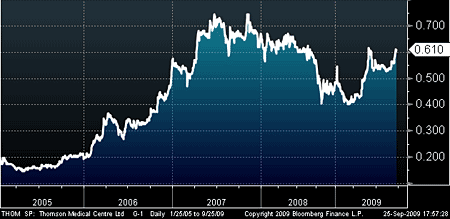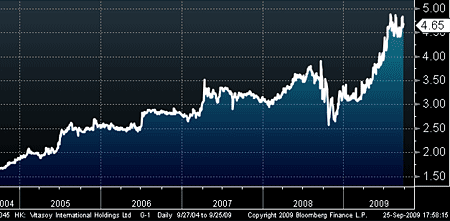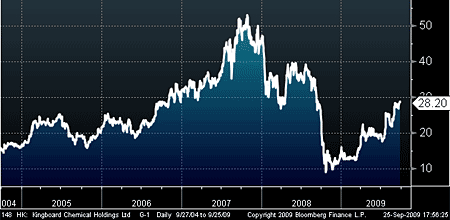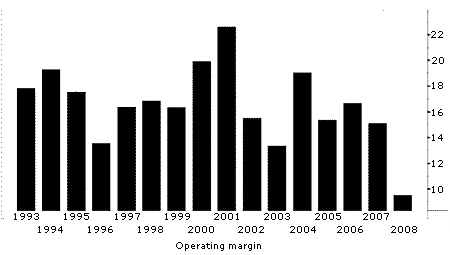The best way to value stocks
Investors are emotional beings - which can make them very bad at valuing stocks. We can't rid ourselves of sentiment, but we can remove some of the bias by looking at valuations in more than one way. Cris Sholto Heaton explains how, and picks two cheap plays on long-term growth in Asia.

I recently wrote a piece about one of my other interests: behavioural finance and the biases that make us less effective investors. If you're a MoneyWeek magazine subscriber, you can read the piece here: Investment strategies: How your mind hobbles your judgementalthough it isn't vital to this article. (If you're not already a subscriber to the magazine, subscribe to MoneyWeek magazine)
The article was all about the way we 'anchor' on the current price of a share. If we like a company, its management, its business model, it's very easy for us to then come up with reasons why the stock is worth significantly more than the market thinks at the moment.
We can't get around this kind of thing entirely. But we can try to reduce the bias by looking at the problem in a more than one way. For example, when valuing a share, we normally think about how fast the firm's earnings will grow, then come up with a valuation based on that. But an alternative way to look at the problem is to work out what earnings growth rate is implied by the existing share price.
MoneyWeek
Subscribe to MoneyWeek today and get your first six magazine issues absolutely FREE

Sign up to Money Morning
Don't miss the latest investment and personal finances news, market analysis, plus money-saving tips with our free twice-daily newsletter
Don't miss the latest investment and personal finances news, market analysis, plus money-saving tips with our free twice-daily newsletter
We can then try to judge whether that rate is realistic, based on the company's track record, and that of similar firms. This can provide a very good reality check. If a company's current share price implies long-term double-digit growth, alarm bells should go off very few companies can manage this kind of growth over many years.
Discounting the future
So how can you do this? Let's assume we're valuing a share using discounted cash flow analysis. This is one of the theoretically correct ways to value an asset. In brief, you estimate what the future cashflows from the asset will be, then discount them back to give a present value in today's terms.
Discounting represents the trade off between a certain amount of money now and a promise of another amount in the future. For example, if an asset will pay £110 in a year's time and you have a discount rate of 10%, the present value of the asset is £100 (= £110/1.1).
The choice of the discount rate depends on the return you can get elsewhere and how risky the investment is. Picking one is a subjective business, which is where the theory runs into problems I'll look at these in a future issue. But since many of the methods used consistently come up with numbers around 10%, I'll use that for convenience in this week's examples.
What I'm going to do for the following stocks, is work out what the future streams of payment implied by the current share price is. There are two things we need to know. The first is that the stream of future cashflows is potentially indefinite, since a share has no fixed maturity the company could still be generating profits fifty years in the future. Second, the company's earnings will hopefully grow over time.
There's a handy mathematical formula for the present value of a series like this: Present Value = Earnings Next Year / (Discount Rate Growth Rate). This works as long as the discount rate is greater than the growth rate.
We can plug in the current share price, the estimated earnings and our choice of discount rate, to get an estimate of the earnings growth being priced in by the stock. So let's take a look at three of my past choices to see how realistically the market is now pricing their prospects.
The best way into Vietnamese healthcare
The first stock I profiled was Thomson Medical Centre, in August 2008. Thomson runs Singapore's largest maternity hospital and a string of clinics across the city-state, but the main reason I was interested in Thomson was that the firm was expanding into neighbouring Vietnam.
This market has excellent growth potential as the country becomes richer and people can pay for better healthcare from the private sector. And Thomson seems to be entering it in a very prudent way: it is providing consultancy and management services for three new-built hospitals to a consortium, with an option to take a 25% stake in the projects once built.
The shares are flat on a year ago, which isn't too disappointing given the upheaval that we've experienced. The total return including reinvested dividends would be around 5%.

News over the past year has been good. Profits for the first nine months of FY2009 were up 9% year-on-year. The first Vietnam hospital is scheduled to open early next year, and is expected to breakeven between the second and third year of operation. The consortium is looking for a suitable site to construct the second in Hanoi, while possible locations for the third are still being studied.
I still think Thomson is a good prospect. It has a strong balance sheet (net cash), a very stable core business and exciting expansion prospects. Assuming full-year profits of around S$0.044 a share and using a discount rate of 10%, the current price implies long-term growth of just 3% or so, which seems quite low.
Since I don't know what Thomson's future growth rate will be, I don't try to estimate an exact fair value for the shares. Instead, I follow the approach outlined by value investor Benjamin Graham: focus on identifying a likely range for fair value by trying out a number of different scenarios.
Enjoying this article? Sign up for MoneyWeek Asia, a FREE weekly email of investment ideas and news every Monday from MoneyWeek magazine, covering the world's fastest-developing and most exciting region. Sign up to MoneyWeek Asia here
For example, a share price of S$0.75 would imply growth of around 4%. A price of S$0.85 implies around 5%, which starts to seem a bit more ambitious. Overall, S$0.7-S$0.9 seems a reasonable range. The stock could be worth substantially more if Thomson turns its foothold in Vietnam into a major chain of hospitals and clinics but there's no way to value that at this stage.
What that means in terms of buying is that I'd be happy to buy into the low S$0.7 range, but not higher. I'm looking to buy shares when they're cheap enough to give myself a margin of safety. Note that S$0.9 is not a sell target at that price, the share should still be reasonably valued. I'd look to sell only if the stock moved substantially above that: I always try to minimise buying and selling, since trading costs are a big drag on profitability for private investors.
A cheap play on Chinese consumption
Thomson is the sort of company I like: small-to-mid-sized, usually with family and founder control. They tend to be ignored because there's little prospect of a takeover and their industries lack glamour, but they're good investments as long as you're patient.
Another stock in the same bracket is Hong Kong's Vitasoy, a food and drink firm specialising in soy-based products. My view when I first profiled it in September 2008 was that the stock was being treated as a stable income play in the mature Hong Kong market, even although it also had fast-growing businesses in mainland China and Australia that would soon account for a larger share of sales and pull up its headline growth rate.
Earnings for the year ended March were up 2.4%. That would be creditable enough given the global recession but it also includes a one-off provision for new rules on holiday pay entitlements. Excluding this, earnings would have been up 13%. All markets performed well and the loss-making North American arm is expected to turn around after exiting a business line there. Mainland China now accounts for 20% of sales and operating profit, from 15% the year before. The firm remains in a healthy net cash position and is continuing to pay out some of its spare funds via a special dividend (it currently yields around 4.7% in total).
The shares are up 27% since September, for a total return of 33%. This partly reflects investors rushing into defensives, but some now seem to be waking up to the hidden growth story in this firm.

It's still cheap. On an EPS of HK$0.24 (ie excluding the one-off provision) and using a discount rate of 10%, the current price implies long-term growth of 5%.
Projecting recent double-digit growth off into the distant future would be reckless few firms can sustain 15%-20% growth in the long-run. Still, given the potential of the mainland market last year, operating profit there was up 50% - it seems reasonable to assume Vitasoy can grow significantly faster than this in the near term, before settling down to a lower long-term rate. Trying out a few such scenarios, I'd put fair value for the stock at around HK$5.5-HK$6.
Buying at the bottom of the cycle
There's a big difference between these two firms and the last one I want to look at today. I profiled Kingboard Chemical Holdings back in January. The firm is a major Chinese producer of printed circuit boards and the intermediate materials to make them, and has also been expanding into chemicals such as methanol.
These are highly cyclical industries, prone to bouts of excess competition, overinvestment and overcapacity. I normally avoid business like these, except at the bottom of the cycle, when everyone else is bearish on them. And back in January, people were very bearish on most Chinese manufacturers, with stocks being priced for armageddon.
Given its low valuation, decent balance sheet and strong position in the industry, Kingboard looked well placed to survive and even profit by grabbing market share or buying distressed assets from weaker rivals. Since then, the firm's shares have roared back as confidence returned; it's currently up 87%, for a total return of 92%.

Kingboard is not a straightforward stock to value, because it's not entirely clear what a 'normal' level of earnings for it will be. Recent earnings have been inflated by the global boom, then crushed by the recession. That didn't matter too much in January; we could afford to be very rough because it was clearly extremely undervalued and would bounce back. But now we need to try to be a bit more precise which is not easy when margins are this volatile (see chart below).

In the first half, profits were HK$1.15 a share. Management is guiding that conditions are looking better. Still, I would assume a reasonable full-year figure would be around HK$2.4. Because this stock is cyclical and there's greater uncertainty over its future earnings, I would want to use a higher discount rate to reflect this perhaps 12.5%. On that basis, the current price implies a long-term growth rate of 4%.
That's not high, but in my view it puts the current price into the lower end of fair value. It could be that Kingboard can grow earnings faster than I expect in the near term as excess capacity in its industries gets shaken out and the Chinese and global economies recover but I don't want to bank on it. I wouldn't be a buyer of the stock at these levels, since there are more attractive prospects elsewhere, but I'd continue to hold it into the high thirties or so.
How much is reasonable?
Overall, I view this as a useful approach to valuation. It's better to admit to uncertainty and focus on what looks reasonable than try to be spuriously precise. Still, it clearly presents plenty of problems.
The most obvious questions are: how high is a reasonable growth rate and how much should we be prepared to pay for it? There isn't an easy answer to these questions, especially the first one. But a look at history gives us some guidelines. I'll take a look at this including some of the most common traps for investors in next week's issue.
This article is from MoneyWeek Asia, a FREE weekly email of investment ideas and news every Monday from MoneyWeek magazine, covering the world's fastest-developing and most exciting region. Sign up to MoneyWeek Asia here
Get the latest financial news, insights and expert analysis from our award-winning MoneyWeek team, to help you understand what really matters when it comes to your finances.
Cris Sholto Heaton is an investment analyst and writer who has been contributing to MoneyWeek since 2006 and was managing editor of the magazine between 2016 and 2018. He is especially interested in international investing, believing many investors still focus too much on their home markets and that it pays to take advantage of all the opportunities the world offers. He often writes about Asian equities, international income and global asset allocation.
Cris began his career in financial services consultancy at PwC and Lane Clark & Peacock, before an abrupt change of direction into oil, gas and energy at Petroleum Economist and Platts and subsequently into investment research and writing. In addition to his articles for MoneyWeek, he also works with a number of asset managers, consultancies and financial information providers.
He holds the Chartered Financial Analyst designation and the Investment Management Certificate, as well as degrees in finance and mathematics. He has also studied acting, film-making and photography, and strongly suspects that an awareness of what makes a compelling story is just as important for understanding markets as any amount of qualifications.
-
 ‘Why I have ditched my Help to Buy ISA for cash savings and the stock market’
‘Why I have ditched my Help to Buy ISA for cash savings and the stock market’Without the 25% bonus, my Help to Buy ISA is effectively redundant, says MoneyWeek writer Sam Walker.
-
 Is your inheritance tax allowance cut if you sell to downsize or sell your home to pay for care?
Is your inheritance tax allowance cut if you sell to downsize or sell your home to pay for care?Downsizing relief is a little-known benefit that could save your loved ones tens of thousands of pounds in inheritance tax after you’ve died.
